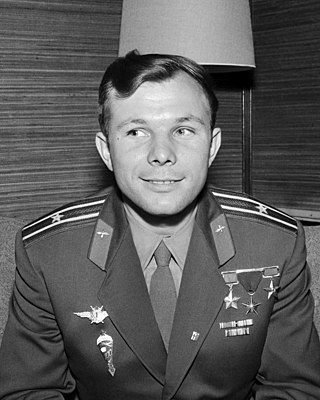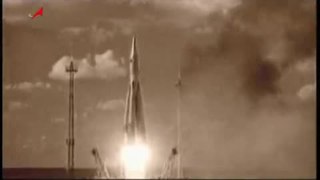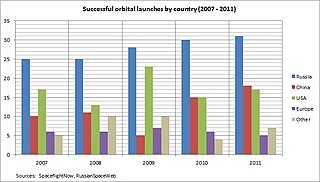
An astronaut is a person trained, equipped, and deployed by a human spaceflight program to serve as a commander or crew member aboard a spacecraft. Although generally reserved for professional space travelers, the term is sometimes applied to anyone who travels into space, including scientists, politicians, journalists, and tourists.

Space exploration is the use of astronomy and space technology to explore outer space. While the exploration of space is carried out mainly by astronomers with telescopes, its physical exploration is conducted both by uncrewed robotic space probes and human spaceflight. Space exploration, like its classical form astronomy, is one of the main sources for space science.

Yuri Alekseyevich Gagarin was a Soviet pilot and cosmonaut who, aboard the first successful crewed spaceflight, became the first human to journey into outer space. Travelling on Vostok 1, Gagarin completed one orbit of Earth on 12 April 1961. By achieving this major milestone for the Soviet Union amidst the Space Race, he became an international celebrity and was awarded many medals and titles, including the nation's highest distinction: Hero of the Soviet Union.

Spaceflight is an application of astronautics to fly spacecraft into or through outer space, either with or without humans on board. Most spaceflight is uncrewed and conducted mainly with spacecraft such as satellites in orbit around Earth, but also includes space probes for flights beyond Earth orbit. Such spaceflight operate either by telerobotic or autonomous control. The more complex human spaceflight has been pursued soon after the first orbital satellites and has reached the Moon and permanent human presence in space around Earth, particularly with the use of space stations. Human spaceflight programs include the Soyuz, Shenzhou, the past Apollo Moon landing and the Space Shuttle programs. Other current spaceflight are conducted to the International Space Station and to China's Tiangong Space Station.

Mars 1, also known as 1962 Beta Nu 1, Mars 2MV-4 and Sputnik 23, was an automatic interplanetary station launched in the direction of Mars on November 1, 1962, the first of the Soviet Mars probe program, with the intent of flying by the planet at a distance of about 11,000 km (6,800 mi). It was designed to image the surface and send back data on cosmic radiation, micrometeoroid impacts and Mars' magnetic field, radiation environment, atmospheric structure, and possible organic compounds.
Mars 5, also known as 3MS No.53S was a Soviet spacecraft launched to explore Mars. A 3MS spacecraft launched as part of the Mars programme, it successfully entered orbit around Mars in 1974. However, it failed a few weeks later.

PAO S. P. Korolev Rocket and Space Corporation Energia, also known as RSC Energia, is a Russian manufacturer of spacecraft and space station components. The company is the prime developer and contractor of the Russian crewed spaceflight program; it also owns a majority of Sea Launch. Its name is derived from Sergei Korolev, the first chief of its design bureau, and the Russian word for energy.

Venera 3 was a Venera program space probe that was built and launched by the Soviet Union to explore the surface of Venus. It was launched on 16 November 1965 at 04:19 UTC from Baikonur, Kazakhstan, USSR. The probe comprised an entry probe, designed to enter the Venus atmosphere and parachute to the surface, and a carrier/flyby spacecraft, which carried the entry probe to Venus and also served as a communications relay for the entry probe.
NPO Lavochkin is a Russian aerospace company. It is a major player in the Russian space program, being the developer and manufacturer of the Fregat upper stage, as well as interplanetary probes such as Fobos-Grunt. As of 2015, it was headed by Sergei Lemeshevskii. On August 10, 2017 the Lavochkin Association's Board of Directors appointed Vladimir Kolmykov Director General of the enterprise.

Phobos 1 was an uncrewed Soviet space probe of the Phobos Program launched from the Baikonour launch facility on 7 July 1988. Its intended mission was to explore Mars and its moons Phobos and Deimos. The mission failed on 2 September 1988 when a computer malfunction caused the end-of-mission order to be transmitted to the spacecraft. At the time of launch it was the heaviest interplanetary spacecraft ever launched, weighing 6200 kg.

Phobos 2 was the last space probe designed by the Soviet Union. It was designed to explore the moons of Mars, Phobos and Deimos. It was launched on 12 July 1988, and entered orbit on 29 January 1989.

Yuri Vasilyevich Kondratyuk, real name Aleksandr Ignatyevich Shargei was a Ukrainian engineer and mathematician in the Soviet Union. He was a pioneer of astronautics and spaceflight, a theoretician and a visionary who, in the early 20th century, developed the first known lunar orbit rendezvous (LOR), a key concept for landing and return spaceflight from Earth to the Moon. The LOR was later used for the plotting of the first actual human spaceflight to the Moon. Many other aspects of spaceflight and space exploration are covered in his works.

The Soviet space program was the national space program of the former Union of Soviet Socialist Republics (USSR), active from 1955 until the dissolution of the Soviet Union in 1991.

Vasily Pavlovich Mishin was a Russian engineer in the Soviet Union, and a prominent rocket pioneer, best remembered for the failures in the Soviet space program that took place under his leadership.

Spaceflight began in the 20th century following theoretical and practical breakthroughs by Konstantin Tsiolkovsky, Robert H. Goddard, and Hermann Oberth. First successful large-scale rocket programs were initiated in the 1920s Germany by Fritz von Opel and Max Valier, and eventually in Nazi Germany by Wernher von Braun. The Soviet Union took the lead in the post-war Space Race, launching the first satellite, the first man and the first woman into orbit. The United States caught up with, and then passed, their Soviet rivals during the mid-1960s, landing the first men on the Moon in 1969. In the same period, France, the United Kingdom, Japan and China were concurrently developing more limited launch capabilities.

The following outline is provided as an overview of and topical guide to space exploration.

Russia's space industry comprises more than 100 companies and employs 250,000 people. Most of the companies are descendants of Soviet design bureaux and state production companies. The industry entered a deep crisis following the dissolution of the Soviet Union, with its fullest effect occurring in the last years of the 1990s. Funding of the space program declined by 80% and the industry lost a large part of its work force before recovery began in the early 2000s. Many companies survived by creating joint-ventures with foreign firms and marketing their products abroad.

Soviet space exploration history has been well documented on Soviet stamps. These Soviet stamps cover a broad spectrum of subjects related to the Soviet space program. While much of the focus has been placed on the nation's notable "firsts" in space flight, including: Earth orbiting satellite, Sputnik 1; animal in space, the dog Laika on Sputnik 2; human in space and Earth orbit, Yuri Gagarin on Vostok 1; first spacewalk, Alexei Leonov on Voskhod 2; woman in space, Valentina Tereshkova on Vostok 6; Moon impact, 1959, and uncrewed landing; space station; and interplanetary probe; numerous stamps have paid tribute to more general astronomical topics as well.

The Planetary Exploration of China, also known as Tianwen, is the robotic interplanetary spaceflight program conducted by the China National Space Administration (CNSA). The program aims to explore planets of the Solar System, starting from Mars, and will be expanded to Jupiter and more in the future.















